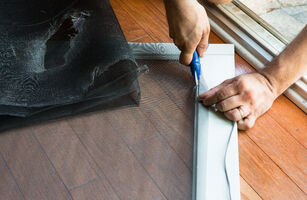Do-it-yourself selection and installation of a screen under the bath
We talk about stationary, sliding screens and models with opening doors, as well as disassemble the installation process of each type.
In standard bathrooms, it is difficult to find a place for free-standing plumbing. In typical premises, convenience and compactness are much more important, but here there is also a place for beauty. An ordinary steel or cast iron hot tub at the bottom does not look very attractive.
Moreover, the space under it often turns into a warehouse of old tools, chemicals and other household utensils. Of course, I want to hide all this from the eyes. You can solve the problem with a decorative screen. We figure out what types are and how to install a screen under the bath.
Stationary screen
The structure is a panel made of materials that are not afraid of high humidity. Wood and plywood are suitable for these purposes only if they are treated with antiseptics and varnish. More often, gypsum plasterboard, chipboard, fiberboard are used to create a base. Tiles are laid out on top, as on the floor or wall, or the panels are covered with wood. This option is not suitable for older houses with weakened ceilings, as the load may be too great. Before starting work, you need to conduct a survey of the floor. This will require the help of an engineering organization with special equipment.
Frame installation
The panels are mounted on a metal profile. A guide is attached to the floor on the dowels. Vertical metal elements are connected to it and mounted on the walls using self-tapping screws. They act as supports for horizontal slats and lintels between them, forming a flat crate. So that it does not bend under the weight of the finish, it is necessary to make a support in the middle. The more such supports, the better. Typically, the pitch is from 0.3 to 0.5 m. These can be metal profiles or adjustable feet, if a gap is planned between the floor and the panel.
To give the system strength, the two corner profiles are folded together or replaced with metal mounting pipes. They are more reliable, but cannot be secured with screws or screws. For installation, you will have to use a welding machine.
Choice of finishing
Solid panels and plasterboards will withstand any kind of cladding. Often used is the material that covers the walls - tiles, tiles made of artificial or natural stone.
Wood or veneer is rarely found in damp rooms, but with good ventilation they will last a long time. They must be treated with antiseptics and water-repellent composition. If the bearing capacity of the floor allows, you can do without finishing by creating a brick base and varnishing it.
Plastic is inferior in its decorative qualities to stone or wood, but has several advantages. It is lightweight. He doesn't need a strong skeleton. The coating does not deform, is not afraid of dampness, and is easy to clean. It is easy to cut and easy to install. If you want to buy the tools click the button below.



